

 |
 |
|
Here, it is just a question of the known varieties of Cattleya eldorado Linden, mentioned in Lindenia and in Martii Flora Brasiliensis, nevertheless I go on with many studies about this species that will be published at the proper time. |
All along my botanical career in the Instituto Nacional de Pesquisas da Amazônia (INPA - National Research Institute of Amazon), in Manaus, I worked, mainly, in the ecosystem of Campina (woodland), with the Orchidaceae family (BRAGA & BRAGA, 1975; BRAGA, 1976; 1977; 1978, 1979; 1981A; 1981B;1981C; 1982A; 1982B; 1983; 1987A; 1987B; BRAGA & VILHENA, 1981; BONATES & BRAGA, 1992 e BRAGA, 1994). |
| In my returning to Amazon, besides the research in Bio-systematic, I have been collecting orchids and ornamental plants, in general, in areas which have been suffering environmental impacts or are about to suffer, mainly Cattleya eldorado Linden, which has 10 described varieties (LINDEN, 1894; COGNIAUX, 1896-1906; MIRANDA, 1982; BRAEM (1986), synonymized the Cattleya eldorado Linden and its varieties a Cattleya |
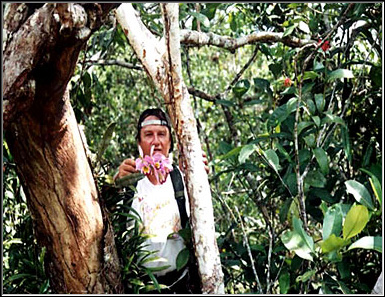 habitat. |
trichopiliochila Barb. Rodr. However I consider valid
the first species with its respective varieties ; LACERDA
(1991) proposed a classification of Cattleya eldorado´s varieties
based on their colors. |
| This
orchid has high ornamental value and is, according to the available information,
restricted to Central Amazon. It occurs in the neighborhoods of Manaus,
in both side of the Rio Negro (Negro River), mainly in the campinas (woodlands),
and nowadays, under strong antropic action, sporadically in igapó (flood
forest) and rarely in terra-firme (drylands).
This species with very ornamental flowers has been collected, since long
time ago, by the time of Brazil colony. One of its areas with greatest occurrence has been submerged, with the construction of the lake of the Hydroelectric Power Plant of Balbina, which gives part of the consumed energy in Manaus, staying, in this way, vulnerable to the extinction. In this period of celebration of the end of the year and the starting of the New Year, this wonderful orchid is in its blooming season, I think, in this way, that this article toasts the readers with this "jewel" of the Amazon nature (Editor note: The author prepared the article to be published in Christmas period, unfortunately, the later magazine was already finished, when we received it, however we decide to maintain this toast) . |
|
Tipo: C. labiata Lindl., Coll. Bot. : t. 33. 1821. Saxicolous or pseudo-terrestrial epiphytic herb. Oblong fleshy pseudobulbs, uni or bifoliate, leaves on the apex of the pseudobulbs. Terminal simple erect pauciflorus inflorescence. Free subequal petals. Petals, in general, bigger than the sepals, rarely equal. Lips, en general, membranaceous, sessil, free or adnate at the base of the column, trilobate, lateral lobes, in general, involving the column. Big column. Four waxy pollinia, evident caudicle. |
|
|
||||||||||||||||||||||||||||||||||||||||||||||||||||||||||||||||||||||||||||||||||||||||||||||||||||
|
|
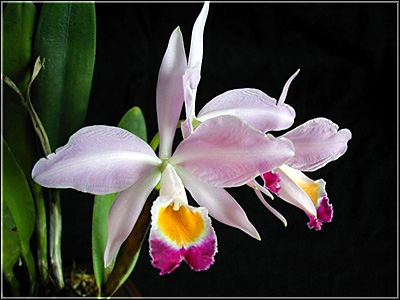 |
Cattleya eldorado Linden,
Fl. des Serres, 28 (13): tab.1826. 1869.
VAR. TIPO. Cattleya wallisii Reichb. f., Gard. Chron. 17: 557. 1882. |
|
|
Epiphytic. Numerous subfasciculate filiform roots, ca. de 70 -100 cm lenght. Smooth cylindrical greenish rhizome, ca. de 1 cm across. Erect oblong, furrowed with age, green pseudobulbs,ca 3-5 cm apart, ca. de 5-15 cm de lenght, ca. 2 cm across. Unifoliate, coriaceous fleshy oblong green leaves, ca. de 5-25 cm lenght, ca. de 3-4 cm across. Simple, erect pauciflorus inflorescence, with 2-5 flowers, arising from the apex of the pseudobulb, ca. 10 cm lenght. Big furrowed green pedicel and ovary, ca. de 3-4 cm lenght. Subequal acuminate sepals, the lateral are falciform, the dorsal is oblong, rose colored, ca. de 4-6 cm lenght, ca. de 1-1,5cm across. Oval petals, apiculate at the apex, rose, ca. de 4-7 cm lenght, ca. de 2-2,5cm across. Trilobed, sessil membranaceous lip, lateral lobes involving the column, the apical with crisped edges, pale rose with yellow or orange axilla and the apical lobe with transversal purple-reddish marking,- ca. de 4-7 cm lenght ca. de 3-4 cm across. Big white column, ca. de 3 cm length. Rose anther. Pollen chamber: two pairs of yellow, waxy pollinea. | |
|
|
In Brazil, this variety is reported to the states of Amazonas and Pará, however, I just saw material placed in herbarium or that I found in natural conditions, in the state of Amazonas. In the Brazilian Amazon, it is, generally, found in woodlands (campinas) and rarely in dryland forests (florestas de terra firme). | |
|
|
Epiphytic mainly in Aldina heterophylla Spr. Ex Benth. (Fabaceae =Leguminosae Papilionoideae), a forophyte tree (which shelters many epiphytes), in shade open woodland (campina) and in umbrous to heliophyte high woodland (Campinarana) . | |
|
|
The plant is perennial and ever green. The vegetative growth occurs during September and October. Then the flower stalk develops to bloom from December to February. Sometimes, we can find blooming plants in April but it is rare. The fructification starts in December and lasts until the beginning of October. In July, the dehiscence of the first fruits start and the most delayed fruits finish their fructification in October. The other varieties, which occur in or next to igapó, bloom from August to October. In general, they are found in a forophyte popularly called "macucú", Aldina heterophylla Spr. Ex Benth. (Fabaceae =Leguminosae Papilionoideae). |
 |
|
 |
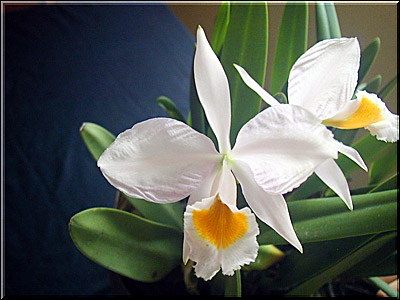 |
Cattleya
eldorado
var. treyeranae Linden, Lindenia, 9(39): tab. 402. 1892. VAR. CONCOLOR. |
|
|
Pale rose sepals and petals; Pale rose lip with yellow-orange suffused fauce. | |
|
|
It occurs in shade woodland (Campina). | |
|
|
It blooms from December to April. |
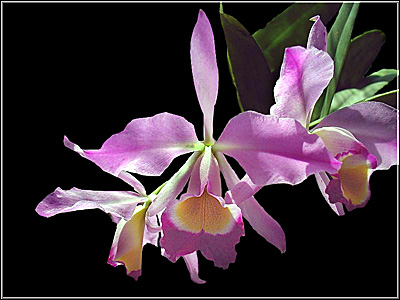 |
Cattleya eldorado
var. splendens Linden, Ill. Hort. 17(36): tab. 7. 1883. VAR. ESPLÊNDIDA. |
|
|
Rosy sepals and petals; Dark rose lip with orange-yellow suffused fauce; The apical lobe and part of lateral lobes are dark purple . | |
|
|
It occurs in or next to the igapó in areas of shoals e woodlands (Campinas) subjected to be overflowed (Hydromorphic Campinas or Campinas de Carana, where the palm tree Mauritia carana is frequent). | |
|
|
It blooms from August to October |
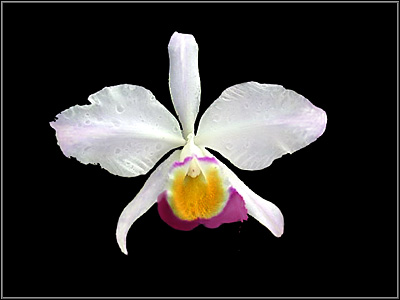 |
Cattleya eldorado |
|
|
Rosy sepals and petals; White lip with orange-yellow suffused fauce; Edges of lateral and apical lobes are purple bordered. | |
|
|
It occurs in or next to Igapó in areas of shoal and Campinas subjected to be overflowed (Hydromorphic Campinas or Campinas de Carana, where the palm tree Mauritia carana is frequent). | |
|
|
It blooms from August to October. |
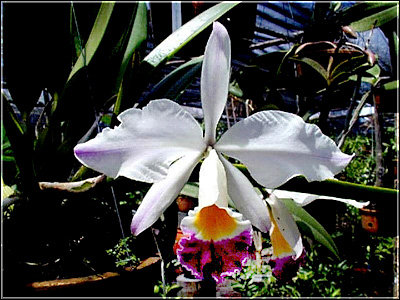 |
Cattleya eldorado
var. crocata Rand., Journ. des Orch. 3:17. 1892. VAR. AQUINADA. |
|
|
Rose sepals and petals. Petals and sometimes sepals with purple to red-purplish blotched edges; White lip with orange-yellow suffused fauce; Purple suffesed apical lobe. | |
|
|
It occurs in or next to Igapó in areas of shoal and woodlands (Campinas) subjected to be overflowed (Hydromorphic campinas or Campinas de Carana, where the palm tree Mauritia carana is frequent). | |
|
|
It blooms from August to October. |
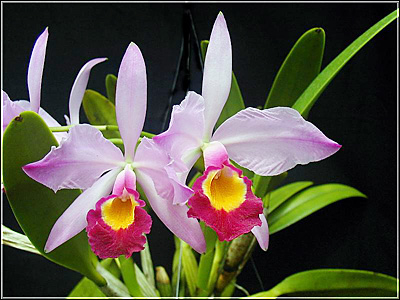 |
Cattleya eldorado
var. lindeni Linden, Lindenia, 9(53): tab. 409. 1894. VAR. AQUINADA. |
|
|
Bright rose sepals and petals; Petals and sometimes sepals with purple to red-purplish blotched edges; Dark roseish lip, with orange-yellow suffesed fauce; Red-purplish suffused apical lobe and edges of the lateral lobes. | |
|
|
It occurs in or next to Igapó in areas of shoal and woodlands (Campinas) subjected to be overflowed (Hydromorphic Campinas or Campinas de Carana, where the palm tree Mauritia carana is frequent). |
|
|
|
It blooms from August to October. |
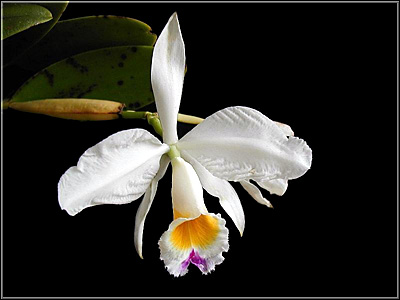 |
Cattleya eldorado
var. oweni Hort., Jour. des Orch. 4: 245. 1893. - VAR. SEMIALBA |
|
|
White petals and sepals; Almost entirely white lib, with orange-yellow suffused fauce; apical lobe with transversal bright rose blotch. | |
|
|
It occurs in woodlands (Campinas). | |
|
|
It blooms from December to April. |
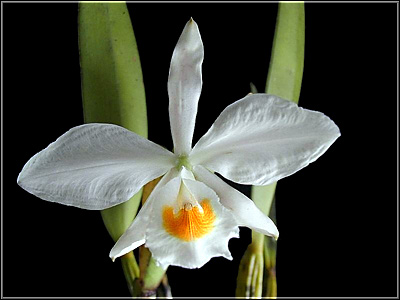 |
Cattleya eldorado
var. alba Rand. Gard. Chron. 23: 760. 1885 VAR. ALBA |
|
|
Medium height plants and flowers with up to 11cm across; White sepals and petals; Almost entirely white lip, with orange-yellow suffesed fauce. | |
|
|
It occurs in the woodlands (Campinas). | |
|
|
It blooms from December to April. |
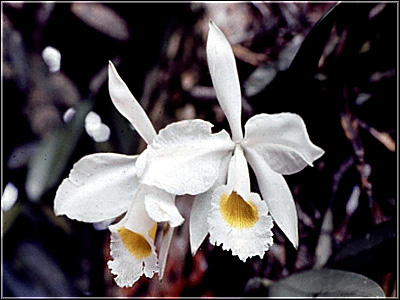 |
Cattleya eldorado
var. virginalis Linden et André, Ill Hort. 23 (161): tab. 257. 1876. - VAR. ALBA. Cattleya eldorado var. virginalis Du buyyss, L' Orchid. 236. 1878. |
|
|
Vigorous height plants and flowers with 14 cm across or more; White petals and sepals; Almost entirely white lip, with a orange-yellow suffused fauce. | |
|
|
Still found in the igapós and shoals next to Manaus and woodlands (Campinas) subjected to be overflowed (Hydromorphic Campinas or Campinas de Carana, where the palm Mauritia carana is frequent). | |
|
|
It blooms from August to October. |
|
Variety
of uncertain position
The published work about this variety is not very elucidative. |
Cattleya
eldorado
var. glebelands Hort., Gard. Chron. 3 (25): 403. 1899. |

This species is very variable and we can notice that there is a remarkable difference between those which occur in flood banks (Igapó) or in the woodlands (Campinas) next to the borders of the rivers regarding to those which occur in drylands (Campinas da Terra-Firme). The firsts have more vigorous plants and bigger flowers than the last ones. It is important to point out that by the time of the discovery of this species and its varieties, the drylands (terra-firme) was not still opened up by the roads which made it difficult to be reached. In Lindenia, it is inclusively mentioned that the first plants that bloom were from the edges of the Negro River (rio Negro) and in Martii Flora Brasiliensis mentioned that they came from Negro and Urubu rivers. The bloom season of those plants are also different. In the igapó, they bloom from August to October and in the dryland, in general, they bloom from December to February Nowadays, the woodlands (Campinas) next to Manaus have been destroyed and the woodlands (Campinas) that I visited were in dryland (terra-Firme) from 60 to 90 km far from the city limits. That could be the mystery why the varieties referred in the work have been discovered recently. After that, I think that we have two eco-types, which are in process of differentiation or even can be considered as vicariate of two subspecies, however, both population have the same characteristic strong scent. Regarding to the shape of the flowers, it is also very variable and the most part of the flowers does not show a good. Concerning the coloration, the flowers vary from the pale rose to dark rose or white flowers. All Cattleya eldorado have the lip with orange suffused fauce. In general, it is possible to find intermediate forms between the varieties that suggest the hybridization of them in natural conditions. As we know, the flora of the Amazon woodlands (Campinas) is, in a big part, originated from the Guianas Shield . On the other hand, with the retraction of the drylands forest (floresta de terra-firme), during the Pleistocene, the connection between the non-forestal types has been extended. In the Quaternary, the forest spread again propitiating a wide differentiation and the relative isolation between the vegetal typologies, because the detachment is not entirely in the oceanic islands. In Roraima, in the border of Brazil and Venezuela, in Pacaraima mountains, 900 km far from Manaus between de 800-1200 m. s. m. occur two other species in the same groupe of C. eldorado, the group Cattleya labiata Lindley, with unifoliate pseudobulbs. The first, Cattleya jenmanii Rolfe, presents purple color with yellow-orange suffused center of the lip, similar to C. eldorado. The second, Cattleya lawrenceana Rchb. f. has purple flowers and petals suffesed in the edges as some varieties of C. eldorado which have been studied in this work. As the orchids have long distance dispersion of seeds by the wind, we can suppose a possible derivation or hybridization of those species. In any way, those observations need more confirmation and, in the future, they will be a subject of a specific publication. The populational studies of their DNA will be necessary, looking for a better understanding of the evolutive process of the differentiation in this (those) species, to detect possible polyploid, hybridization and or a possible genetic introgression between the mentioned species!? |
|
(*)
(**) |
Prof. MSc., DSc., Titular of Biology Departament , Sector of Genetics, Molecular
Biology and Evolution of the Biological Institute of Sciences , Universidade
Federal do Amazonas, Manaus-AM. E-mail: pisbraga@fua.br e/ou pisbraga@ig.com.br Work sent to be published in January 2002. |
| BONATES,
L.C. de M. & BRAGA, P.I.S. |
1992
|
Ecophysiological
studies of the Orchidaceae of Amazon I. - Identification of the way C3
and CAM in fourteen species which grow in the terrestrial stratum of a
wooland (campina) in Central Amazon. Bol. Mus. Para. Emílio Goeldi, sér. Bot., 8 (2): 163-189. |
| BRAEM, G. J. | 1986 | Cattleya
Band II - Die unifoliaten (einblättrigen) Cattleyen. Germany, Hildesheim D-3200, Brücke-Verlag Kurt Schmersow. p.81-83. |
| BRAGA,
M.M.N. & BRAGA, P.I.S. |
Ecological
studies in the woodland situated in Biological Reserve of INPA-SUFRAMA)
(Campina da Reserva Biológica INPA-SUFRAMA, Km 45). Acta Amazon. Manaus, 5(3): 247-260. |
|
BRAGA, P.I.S.
|
1976
|
Attraction of the pollinator bees of Orchidaceae with the help of odoriferous bait, in woodlands, high woodlands and humid Tropical Forest in the region of Manaus (Woodland, high woodlands and tropical forest). Ciênc. Cult, 28 (7): 767-773. |
|
1977
|
Biological
aspects of the Orchidaceae in a woodland of Central Amazon (campina).
Acta Amazon. Manaus , 7 (2), Suplemento: 89p. |
|
|
1978
|
Studies of the orchidaceous flora of the State of Amazonas III- Brassocattleya
rubyi Braga (Orchidaceae) a new hybrid of the Amazon flora. Acta Amazon. Manaus, 8 (3): 371-378. |
|
|
1979
|
Phytogeographic subdivision, types of vegetation, conservation and floristic survey of in Amazon forest. In: Strategies for forestal politic in the Braziilan Amazon. Acta Amazon. Manaus, 9 (4): 53-80. Suplemento. | |
|
1981a
|
Orchids from Brazilian Amazon. Bol. Assoc. Orquid. Amazon., 1 (2): 16-24 |
|
|
1981b
|
Orchids from the woodlands (Campinas) of Brazilian Amazon. Bradea, 3 (23): 170-173. |
|
|
1981c
|
Orchids from the woodlands (Campinas) of Brazilian Amazon. In: Proceedings of the First Meeting of Orchidists and e Orchidologists of Brazil, Rio de Janeiro, Expressão e Cultura. p. 19-43. |
|
|
1982a
|
Orchids from Brazilian Amazon II. Bol. Assoc. Orquid. Amazon., 2 (1): 85-88. |
|
|
1982b
|
Biological Aspects of the Orchidaceae in a woodland (Campina) of Central Amazon. II- Phytogeography of the woodlands of Brazilian Amazon. Thesis of doctor's degree presented in the cours of post-graduation in INPA-UFAM. 345 p. |
|
|
1983
|
Phytosociology of the Orchidaceae family I. Bol. Assoc. Orquid. Amazon., 3 (5): 185-188. |
|
|
1987a
|
Orchids- Entry and Dispersion in the Amazon. Ciênc. Hoje, 5 (28): 44-51 |
|
|
1987b
|
Orchids - Floral Biology. Ciênc. Hoje, 5 (28): 52-56. |
|
|
1994
|
Orchids from Brazilian Amazon III. Bradea, 6 (35): 293-296. |
| BRAGA, P.I.S. & VILHENA, R. |
1981
|
Studies about the vegetation of the Amazon woodlands (Campinas) VII.- Ecological Anatomy of Epidendrum huebneri Schltr. and Phthirusa micrantha Eichl. In: Proceedings of the First Meeting of Orchidists and Orchidologists of Brazil. Rio de Janeiro, Expressão e Cultura. p. 86-106. |
| CRUZ, J. da & BRAGA, P.I.S. |
1996
|
Considerations
about the relation of the Epiphytic Orchidaceae with their forófitos
in forest of dryland (terra firme) in the petroleum field of the Urucu
river medium Solimões, Amazon - Brazil. Rev. UA, Série: Ciências Biológicas, Manaus, 1 (1): 17-29 |
|
1997
|
Taxonomical and Ecological Aspects of the Epiphytic Orchidaceae in the petroleum field of the Urucu, Amazon - Brazil. Rev. UA, Série: Ciências Biológicas, Manaus, 1 (1): 1-129 |
| COGNIAUX, A. |
1896
|
Orchidaceae.
In: Martii Flora Brasiliensis, 3 (4): 1 - 641. 133 tabs. |
|
1902
|
Orchidaceae.
In: Martii Flora Brasiliensis, 3 (5): 1 - 644. 119 tabs. |
|
|
1906
|
Orchidaceae.
In: Martii Flora Brasiliensis, 3 (6): 1 - 604. 120 tabs. |
| GREUTER, W. ET AL. |
2000
|
International
Code of Botanical Nomenclature (St. Louis Code), Koeltz Scientific Publications, Königstein, Germany. |
| LACERDA Jr. |
1991
|
K.
Cattleya eldorado Linden. Boletim CAOB, 3 (4): 4-11. |
| MIRANDA, F. L. |
1982
|
The varieties of Cattleya eldorado Linden. Bol. Assoc. Orquid. Amazon., 2 (2): 91-95. |
| PABST, G.F.J. & DUNGS |
1975
|
Orchidaceae
brasilienses, 1. Hildesheim, Brücke-Verlag Kurt Schmersov. 408 p. |
| van den BERG, C. |
2001
|
Lindleyana 16(3):142-143. |
|
- Campina (Woodland) - Type of vegetation that occurs in forest of drylands (terra-firme), or next to Igapó, with clay soil, strong illuminated and small trees with tortuous branches similar to woodland savannah of Central Brazil or that vegetation which occurs in fields of drylands (terra-Firme) in the states of Pará, Rondônia, Roraima and Amapá. - Conservation - maintenance of natural preserved areas, or species, through a set of rules and legal scientific criterions. - DNA - deoxyribonucleic acid, complex organic molecule found in all plants and animal and the most part the virus, which brings the genetic information transmitted to the next generation. - Dryland Forest (Terra-Firme) - Forests that occur in areas which are not subjected to be overflowed. They can be: Dense, Hillside, Liana (Cipó), Open, Woodlands (Campinas) (open, shaded, high and Campinaranas). - Eco-types - one or more population of a certain species genetic or physiologically differentiated in such a way to be adapted to specific conditions. - Forophyte - plant with all conditions to shelter epiphytes, with wrinkled bark, nutrients, many branches in a horizontal or almost horizontal position or close that make easy the accumulation of the humus. - Genetic introgression - introduction of one or more genes from a species to another by the hybridization. - Igapó - typical vegetation of the rivers with dark water such as the Negro river but can occur in the lakes of the Várzea. Environmental impacts areas- areas that suffered sudden natural or antropic alterations, in all environment, or in some of the components.. - Management - of the resources of the environment, air, water, mineral soils and alive species, include the man in order to get the highest quality of sustained life. - Phytogeography - distribution of plants and typologies of vegetation in the Earth. - Pleistocene - period of the geological age, at the beginning of the Quaternary, where occurred the last glaciation or cooling of the face of the Earth.. - Polyploid - the one that has three or more series of chromosomes. - Pseudo-terrestrial - orchids found growing in sandsoil, latosol and rocks, presenting roots with velamen, characteristic of the epiphyte plants. - Reproductive Biology - study of the life of the plant which includes the study of the distribution, phenology, pollination, fecundation and dispersion of the seeds. - Saxicolous - that occurs in the rock, different from the rupiculous that occurs among the rocks. - Systematic - the study of the species and the diversity of the organisms and all relation existent between them. - Subspecies - hierarchical category below the species that present evolutive characteristics of differentiation, which do not yet allowed considered it as an independent species. - Taxonomy - is the science that deals with the identification, nomenclature and classification of the objects of biological nature. - Vicariate - the occurrence of a pair of con-generic species or subspecies, living in different habitats of a geographical area and never found in the same community. |